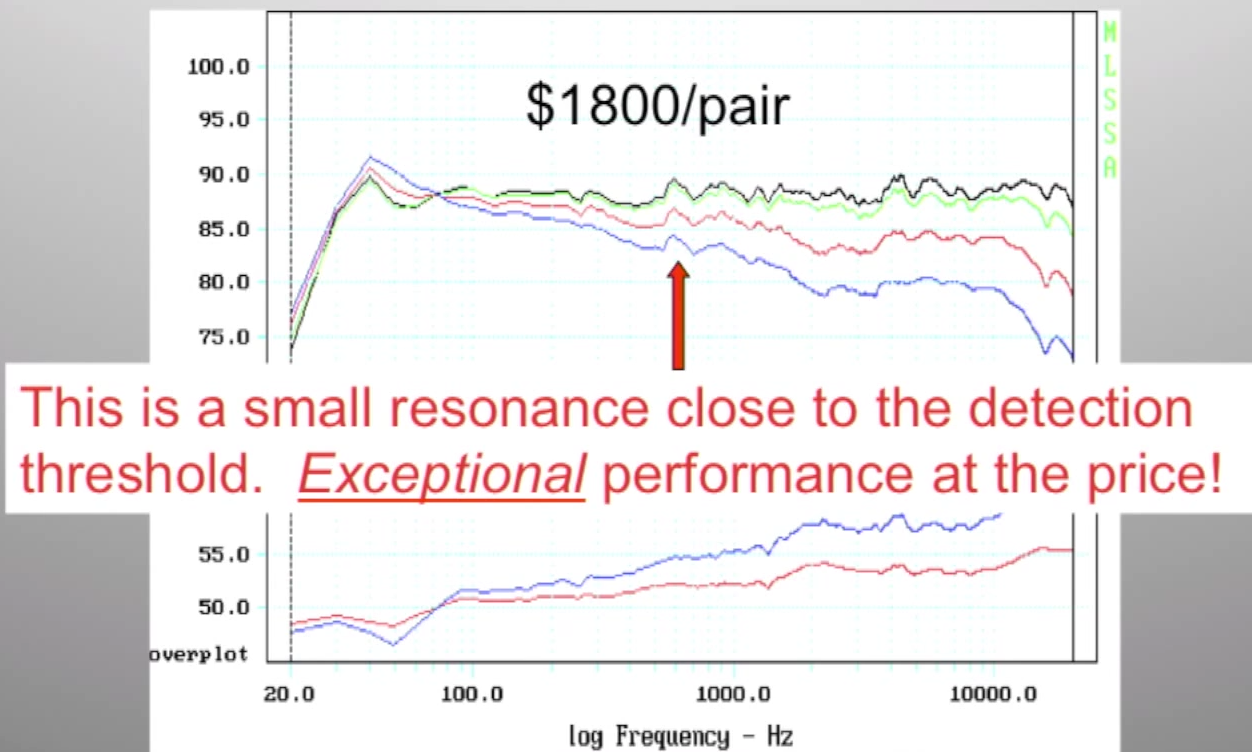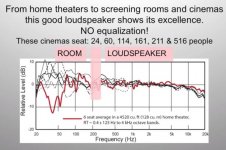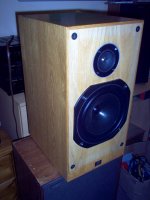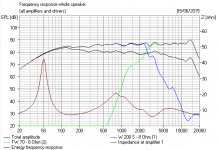Hello,
here is the link of a good talk by Floyd Toole
https://www.youtube.com/watch?v=zrpUDuUtxPM
and which loundspeaker did he show us here?

Anyone?
Best
Thomas
here is the link of a good talk by Floyd Toole
https://www.youtube.com/watch?v=zrpUDuUtxPM
and which loundspeaker did he show us here?

Anyone?
Best
Thomas
In the Audioholics forum he says it was an Infinity Interlude series speaker:
Harman Research vs Consumer Product Development Are They Related? | Audioholics Home Theater Forums
Harman Research vs Consumer Product Development Are They Related? | Audioholics Home Theater Forums
this it? Interlude IL60

halfway down:
http://www.avsforum.com/forum/89-sp...till-running-infinity-speakers-like-me-5.html

halfway down:
http://www.avsforum.com/forum/89-sp...till-running-infinity-speakers-like-me-5.html
I enjoyed that Thomas. Thankyou. 
I thought some of Floyd's more interesting comments came near the end. In which he said that below 200Hz you hear mostly the room and the placement, above that you hear mostly the speaker.
Well he's talking about the high-tech JBL M2 horn speaker here which gets quite directional I expect, so we might adapt that slightly for regular direct radiator speakers.
I listen to a lot of live and recorded disco music in a big hall as part of my job. I'm always struck by how different the two types sound down the hallway. Disco has heavy bass and limited dynamic range, the live (real big band) stuff is lighter on the bass and heavier on the energy overall.
I suspect the recorded stuff would sound much closer to the live stuff if we built the speakers into the wall and did away with bafflestep. As it is, listening to my neighbour's sound from outside, it always sounds bassy. This is all about ROOM GAIN at low frequencies.
My own taste is a compromise. I reduce the bass bafflestep and place close to the wall to get nearer flat power response at the low end. Because bafflestep is actually a boost to the overall bass power. Less of a contrast between the direct sound (which YOU hear) and room sound (which your NEIGHBOURS down the hallway hear) IMO.
I also think that matching the room sound to the direct sound is important. I always notice how LR4 sounds great at the direct listening spot, but move round the room and the flatter power BW3 sounds more natural. You really can hear the power response of the crossover too.
Here's something interesting called "Audibility of different crossover types", from which I quote below:
http://www.ctc-dr-weber.de/speaker/Audibility%20of%20different%20crossover%20types.pdf
I thought some of Floyd's more interesting comments came near the end. In which he said that below 200Hz you hear mostly the room and the placement, above that you hear mostly the speaker.
Well he's talking about the high-tech JBL M2 horn speaker here which gets quite directional I expect, so we might adapt that slightly for regular direct radiator speakers.
I listen to a lot of live and recorded disco music in a big hall as part of my job. I'm always struck by how different the two types sound down the hallway. Disco has heavy bass and limited dynamic range, the live (real big band) stuff is lighter on the bass and heavier on the energy overall.
I suspect the recorded stuff would sound much closer to the live stuff if we built the speakers into the wall and did away with bafflestep. As it is, listening to my neighbour's sound from outside, it always sounds bassy. This is all about ROOM GAIN at low frequencies.
My own taste is a compromise. I reduce the bass bafflestep and place close to the wall to get nearer flat power response at the low end. Because bafflestep is actually a boost to the overall bass power. Less of a contrast between the direct sound (which YOU hear) and room sound (which your NEIGHBOURS down the hallway hear) IMO.
I also think that matching the room sound to the direct sound is important. I always notice how LR4 sounds great at the direct listening spot, but move round the room and the flatter power BW3 sounds more natural. You really can hear the power response of the crossover too.
Here's something interesting called "Audibility of different crossover types", from which I quote below:
http://www.ctc-dr-weber.de/speaker/Audibility%20of%20different%20crossover%20types.pdf
On to the crossover filters: here are our findings point by point for the xo at 1 kHz:
• BW1: deviates, just like most of the filters, from the REF. Rather surprising because 1st order filter slopes should be ideal in many respects. With a piece of music the differences are not as easy to hear.
BW1 and BW3 have the same character.
• LR2: A clear loss of energy around the crossover point was audible.
• LR4 also gives a clear deviation with regard to the balance of the REF. Also there is less power on and around the xo point. With pink noise very clearly audible, with music also, but the perceived differences are not unpleasant, although slightly lean.
• LR8 gives a clear improvement on LR4, probably because the transition is narrower, as a result of which dips (in the power response) are less notable.
• Bess2: (As in Lynn Olson's Ariel, FWIW, S7) Big surprise. Of all filters the closest sounding to the REF using pink noise.
• BW3 and BW3-i followed the footsteps of Bess2, very similar to REF. In general the even and odd order filters form groups with similar character in perceived sound. Odd order filters came nearer to the REF... except Bess2. We found the following explanation for this: textbook Bess2 (which is what we're talking about) has a hump of nearly 1.25 dB at the xo point. This on-axis excess energy compensates for the loss of power off-axis with this even order filter.
Attachments
Last edited:
It's interesting that PA people often end up with the vertical 4X 12" or 15" cabinet.
This has an interesting horizontally lobed projection that falls off less with distance than single drivers. The people at the back hear it as well as the people at the front. I think in my dreams I'd use multiple drivers, which dominate the room acoustics. But economics dictates it simpler...
Here's Steen Duelund's thoughts on the room and the cabinet:
You have to think about reflections from wall boundaries, which are not in the diagram, to really make sense of it. But interesting, nevertheless. I'd regard crossover power musings as slightly separate.
This has an interesting horizontally lobed projection that falls off less with distance than single drivers. The people at the back hear it as well as the people at the front. I think in my dreams I'd use multiple drivers, which dominate the room acoustics. But economics dictates it simpler...
Here's Steen Duelund's thoughts on the room and the cabinet:
An externally hosted image should be here but it was not working when we last tested it.
You have to think about reflections from wall boundaries, which are not in the diagram, to really make sense of it. But interesting, nevertheless. I'd regard crossover power musings as slightly separate.
Let's ask a simpler question. Can any sound system convince you that you are listening in a cavernous space like the Albert Hall within the confines of your small room? Apart from headphones, I don't think so.The off-axis measurements Toole presents seem to be taken only in the horizontal plane (unless the good examples he shows were all fullrange or coaxial loudspeakers) , yet the spinorama measurements he discusses are taken in both horizontal and vertical plane.
Your ears are extremely good at judging what sort of space you are currently in. You listen for echoes. It's a survival instinct. You can even pick up acoustically if you are near a crevasse or edge or terminal fall which might kill you.
I think Floyd Toole is overdoing the merits of flat frequency response. It's not the whole picture, because phase is often as interesting IMO. A big kink in phase implies energy storage and ringing.
Here's the Acoustic Research MST. It's designed to go against a wall and is a low bafflestep design. It meets many of my requirements for a dynamic speaker:
An externally hosted image should be here but it was not working when we last tested it.
But really, who are we kidding? You can't recreate the Albert Hall in your living room. Just get near enough that it sounds good and gets you involved. I think Troels Gravesen said that you must just take out the nasties that shout "I am here" in a bad speaker. The speaker really should disappear.
i didnt ask a question, your reply has little or nothing to do with my post so why quote it. btw that speaker you show is more or less the inverse of what i would call an ideal loudspeaker in terms of directivity, prone to giant lobing problems with 4 tweeters spread around like that
I usually follow my muse with these sort of topics. Floyd Toole was talking about satisfying all the listeners around an auditorium. This is a little different from satisfying a single listener in your typical nearfield sweet spot.
The fact it seemed like a giant advert for Harmon-Kardon products is neither here nor there.
I like throwing in slightly radical designs like old Acoustic Research designs, if only to keep you thinking that there's more than one way to skin a cat. The MST was a poor man's LST. The three way LST was designed for auditoriums and worked well in them.
Edgar Villchur, Henry Kloss and Roy Allison were three of the greats of audio in the days when it was mostly about listening rather than measurement, though they could measure as well. So you might not be too hasty in dismissing the MST.
It has many of the elements that people are now rediscovering about good dynamics. And is also designed to sound good all around the room.
The fact it seemed like a giant advert for Harmon-Kardon products is neither here nor there.
I like throwing in slightly radical designs like old Acoustic Research designs, if only to keep you thinking that there's more than one way to skin a cat. The MST was a poor man's LST. The three way LST was designed for auditoriums and worked well in them.
Edgar Villchur, Henry Kloss and Roy Allison were three of the greats of audio in the days when it was mostly about listening rather than measurement, though they could measure as well. So you might not be too hasty in dismissing the MST.
It has many of the elements that people are now rediscovering about good dynamics. And is also designed to sound good all around the room.
Last edited:
I read his book, "Acoustics and Pshychoacoustics of loudspeakers and Rooms", a couple of years ago and recently read it once more.
Some very interesting and probably correct points he makes in the book. Most of this is repeated in this lecture.
His views about listening to the room (actually the interaction between the room and the loudspeaker) in the low frequencies is obviously correct and supported by most acoustics engineers.
Some of his views are rather contrary to popular beliefs. Like the statement that mounting absorbers at the first reflection points is rather wrong, as it destroys envelopment.
Some very interesting and probably correct points he makes in the book. Most of this is repeated in this lecture.
His views about listening to the room (actually the interaction between the room and the loudspeaker) in the low frequencies is obviously correct and supported by most acoustics engineers.
Some of his views are rather contrary to popular beliefs. Like the statement that mounting absorbers at the first reflection points is rather wrong, as it destroys envelopment.
Well he's talking about the high-tech JBL M2 horn speaker here which gets quite directional I expect, so we might adapt that slightly for regular direct radiator speakers.
Actually, it's not. The horn is designed for a 120º pattern.
As for the $1800 loudspeaker in question, I suspect it's the Interlude IL50. That seems to be closest in price to Dr. Toole's claim (1700 sticker vs 1800, according to Google; but he was speaking in Canada so might have been using Canadian pricing). However, it could be the IL60, which according to Google stickered for $2500 so may have been widely available for $1800. The difference is the IL60 is a three-way plus sub design.
- Status
- This old topic is closed. If you want to reopen this topic, contact a moderator using the "Report Post" button.
- Home
- Loudspeakers
- Multi-Way
- Good talk by Toole and which loudspeaker is this?


